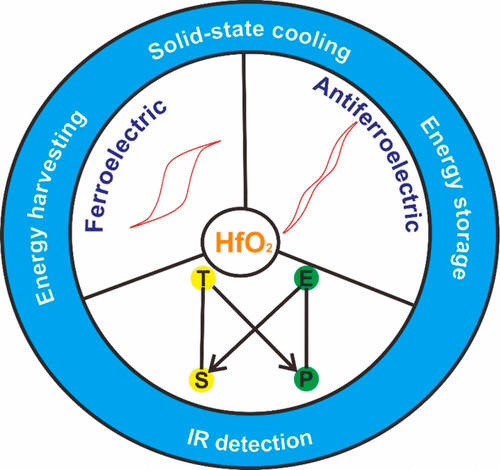当前位置:
X-MOL 学术
›
ACS Appl. Electron. Mater.
›
论文详情
Our official English website, www.x-mol.net, welcomes your
feedback! (Note: you will need to create a separate account there.)
Recent Progress on Energy-Related Applications of HfO2-Based Ferroelectric and Antiferroelectric Materials
ACS Applied Electronic Materials ( IF 4.3 ) Pub Date : 2020-07-23 , DOI: 10.1021/acsaelm.0c00304
Faizan Ali 1, 2 , Dayu Zhou 1 , Mohsin Ali 1 , Hafiz Waqas Ali 1 , Muhammad Daaim 1 , Sheeraz Khan 1 , Muhammad Muzammal Hussain 1 , Nana Sun 1
ACS Applied Electronic Materials ( IF 4.3 ) Pub Date : 2020-07-23 , DOI: 10.1021/acsaelm.0c00304
Faizan Ali 1, 2 , Dayu Zhou 1 , Mohsin Ali 1 , Hafiz Waqas Ali 1 , Muhammad Daaim 1 , Sheeraz Khan 1 , Muhammad Muzammal Hussain 1 , Nana Sun 1
Affiliation

|
Ferroelectric and antiferroelectric materials are promising options for energy-related (such as energy harvesting, energy storage, IR detection, and refrigeration) and memory applications (such as ferroelectric random-access memory (FeRAM) and ferroelectric field-effect transistor (FeFET)). In the past, several classes of materials (such as polymers, ceramics, single crystals, and glasses) have been studied for these properties. However, because of a large deposition thickness (in micrometers or larger), these materials are inappropriate for future nanoscale devices. Recently, the ferroelectric and antiferroelectric HfO2-based thin films have also been studied for the energy-related and memory applications. HfO2-based materials have many advantages over the conventional materials, such as compatibility with Si-based semiconductor technology, ultrasmall thicknesses (nm), and simple compositions, and they are appropriate for integration within 3-D nanostructures. HfO2-based materials can be promising for energy-related applications, such as energy storage, pyroelectric energy harvesting, IR sensors, and solid-state cooling. This article provides some basic knowledge of these energy-related properties. Moreover, this article reviews the energy-related properties of HfO2-based thin films, their origins, and the prospects of this research field.
中文翻译:

基于HfO 2的铁电和反铁电材料在能源相关应用方面的最新进展
铁电和反铁电材料是与能源相关的(例如能量收集,能量存储,IR检测和制冷)和存储应用(例如铁电随机存取存储器(FeRAM)和铁电场效应晶体管(FeFET))的有前途的选择。过去,已经针对这些性能研究了几类材料(例如聚合物,陶瓷,单晶和玻璃)。但是,由于沉积厚度大(微米或更大),因此这些材料不适用于未来的纳米级器件。近来,也已经研究了基于HfO 2的铁电和反铁电薄膜用于与能量有关的和存储器应用。HfO 2基材料比常规材料具有许多优势,例如与硅基半导体技术的兼容性,超小厚度(nm)和简单的成分,它们适合集成在3-D纳米结构中。基于HfO 2的材料在与能源相关的应用中很有希望,例如能量存储,热电能量收集,IR传感器和固态冷却。本文提供了有关这些与能量有关的属性的一些基本知识。此外,本文回顾了基于HfO 2的薄膜的能量相关特性,其起源以及该研究领域的前景。
更新日期:2020-08-25
中文翻译:

基于HfO 2的铁电和反铁电材料在能源相关应用方面的最新进展
铁电和反铁电材料是与能源相关的(例如能量收集,能量存储,IR检测和制冷)和存储应用(例如铁电随机存取存储器(FeRAM)和铁电场效应晶体管(FeFET))的有前途的选择。过去,已经针对这些性能研究了几类材料(例如聚合物,陶瓷,单晶和玻璃)。但是,由于沉积厚度大(微米或更大),因此这些材料不适用于未来的纳米级器件。近来,也已经研究了基于HfO 2的铁电和反铁电薄膜用于与能量有关的和存储器应用。HfO 2基材料比常规材料具有许多优势,例如与硅基半导体技术的兼容性,超小厚度(nm)和简单的成分,它们适合集成在3-D纳米结构中。基于HfO 2的材料在与能源相关的应用中很有希望,例如能量存储,热电能量收集,IR传感器和固态冷却。本文提供了有关这些与能量有关的属性的一些基本知识。此外,本文回顾了基于HfO 2的薄膜的能量相关特性,其起源以及该研究领域的前景。

































 京公网安备 11010802027423号
京公网安备 11010802027423号